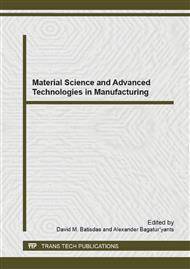p.396
p.401
p.406
p.412
p.419
p.427
p.432
p.437
p.441
Stability Modeling and Analysis of Orthogonal Turn-Milling with Variable Cutting Depth and Cutting Thickness
Abstract:
In orthogonal turn-milling process, both of the workpiece and the cutter rotate at the same time, which causes cutting depth and cutting thickness to change instantaneously. In this paper, a new 2D stability model of orthogonal turn-milling is established, in which the effect of variable cutting depth and cutting thickness is considered. The stability lobe diagrams are obtained by using Full-discretization Method. By analyzing the stability of orthogonal turn-milling, it is found that it is better than that of ordinary milling in same machining conditions. It means that in orthogonal turn-milling process deep cutting depth can be chosen and high machining efficiency can be obtained compared to that in ordinary milling process.
Info:
Periodical:
Pages:
419-426
Citation:
Online since:
January 2014
Authors:
Price:
Сopyright:
© 2014 Trans Tech Publications Ltd. All Rights Reserved
Share:
Citation:


